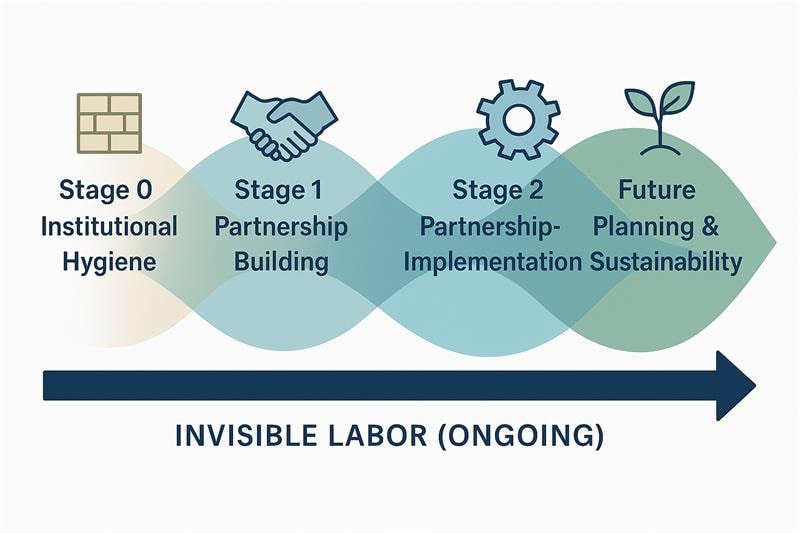
What is this team working on?
Invisible Labor team members are finalizing three journal manuscripts; manuscripts are anticipated to be submitted for peer review by the year’s end. Each manuscript highlights different components of hidden work undertaken by a co-equitable transfer partnership we pseudonymized as STEM UP. For this project, our team defined a co-equitable community college-university transfer partnership as one that counters traditional institutional hierarchies, values the distinct strengths of all partner institutions, and prioritizes mutual institutional learning.
The first manuscript poses the overarching question, “What invisible labor underpins a co-equitable transfer partnership?” Team members blended a critical qualitative inquiry lens with a case study approach to reveal distinct but interwoven domains of invisible labor: Individuals’ beliefs about and motivations to serve transfer students, individual and institutional resources, communication, and coordination. Analysis revealed that the construct of invisible labor within a co-equitable partnership is categorically messy, suggesting that the activities associated with invisible labor are hard to disaggregate. Invisible labor appears to be closely tied to relational work within a co-equitable partnership and the development of partnership capital, which Eddy and Amey define as a unique form of resource for collaborators that builds on the trust, shared meaning, and strategic alignment generated by partners.
The second manuscript introduces the concept of institutional hygiene to describe the internal cultural and structural readiness required for universities to form co-equitable partnerships with community colleges to support STEM transfer students. Drawing from a narrative inquiry situated within the larger PROSPECT study, we focused on one private university anonymized as Agate Bed University (ABU) and its efforts to “get its house in order” prior to launching a multi-institutional partnership. Using interviews from ABU and its community college collaborators, we examined the invisible labor performed by one staff member who led systemic policy revisions, cultivated cross-institutional trust, and built an ecosystem of support for transfer students. Her story illustrates that readiness for partnership is not achieved through policy alone, but through sustained relational work: educating faculty and administrators, building trust, elevating transfer student narratives, and embedding transfer equity into institutional culture. By naming these practices as institutional hygiene, we highlight the often unseen maintenance work that precedes successful collaborations. The framework offers a practical lens for higher education practitioners to assess their own institutional readiness and to engage intentionally in the hidden, ongoing labor necessary to create and sustain equitable transfer ecosystems.
The third manuscript examines how invisible labor unfolds over time, asking “What is the trajectory of invisible labor in a successful transfer partnership?” Using interview data from the STEM UP collaboration, team members identified four interrelated stages that characterize the life cycle of partnership work (as shown in the figure below): (0) Institutional Hygiene, (1) Partnership Building, (2) Partnership Implementation; and (3) Future Planning & Sustainability. This stage-based framework expands Amey and Eddy’s strategic partnership model by introducing a crucial pre-partnership phase and illuminating how the relational, bureaucratic, and advocacy work of faculty and staff shifts across the lifespan of a collaboration. The manuscript provides a nuanced insight into the human infrastructure that sustains co-equitable transfer partnerships and suggests practical strategies for incorporating invisible labor into formal responsilities—enabling partnerships to endure long after funding ends.
What’s next?
The invisible labor team hopes to present the above findings at the April 2026 meeting of the Council for the Study of Community Colleges; we’re waiting to hear if our symposium proposal is accepted.
Some of us are also creating a poetic transcription from interview transcripts to address the question: How is trust developed among people in an equity-minded community college-university STEM student transfer partnership?
This summary was provided by the Invisible Labor team: Camilla Morone (UNL), Chris Varney (UNL), Leen-Kiat (UNL), Michelle Maher (UMKC), Mindi Searls (UNL), Wendy Smith (UNL).